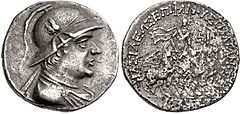Plato of Bactria


Plato Epiphanes(Ancient Greek:Πλάτων ὁ ἘπιφανήςPlátо̄n ho Epiphanḗs,"Plato the God-Manifest" ) was aGreco-Bactrianking who reigned for a short time in southernBactriaor theParopamisadeduring the mid 2nd century BCE. The style of Plato's coins suggests that he was a relative — most likely a brother since Plato is a middle-aged man on his coins — ofEucratides the Great,whose rise to power is dated to around 170–165 BCE.
Some of Plato's coins have inscriptions which may possibly be interpreted as dates using theIndo-Greek erawhich started around 186 BCE. In that case Plato ruled around 140 BCE. This matches the dating given by numismaticianBopearachchi,who places Plato between 145–140 BCE, since his coins are not found in the ruins ofAi Khanoum,a Bactrian city which was destroyed during the reign of Eucratides.
Coinage[edit]
-
Silver coin of Plato Epiphanes wearing a crested Bactrian helmet adorned with bull's horn and ear.
-
Another coin of Plato Epiphanes, bare headed and wearing a diadem.
See also[edit]
- Greco-Bactrian Kingdom
- Seleucid Empire
- Greco-Buddhism
- Indo-Scythians
- Indo-Parthian Kingdom
- Kushan Empire
References[edit]
- "The Shape of Ancient Thought. Comparative studies in Greek and Indian Philosophies"by Thomas McEvilley (Allworth Press and the School of Visual Arts, 2002)ISBN1-58115-203-5
- "Buddhism in Central Asia" by B. N. Puri (Motilal Banarsidass Pub, January 1, 2000)ISBN81-208-0372-8
| Preceded by: Eucratides I? |
Greco-Bactrian Ruler (Bactriaor its tributaries) |
Succeeded by: Eucratides II? |


